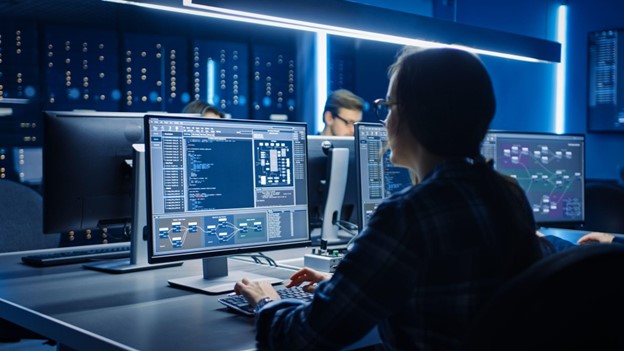Integrating smart fire detection systems in commercial buildings is very important for ensuring the safety of occupants, assets, and business continuity. Fires can be devastating, causing massive damage and putting hundreds of lives at risk. Traditional fire detection systems have limitations, making smart systems a vital upgrade. By adopting smart fire detection technology, commercial buildings can enhance their safety measures, providing an added layer of protection and peace of mind.
This proactive approach helps prevent fires, reduces false alarms, and ensures swift emergency responses, ultimately creating a safer and more secure environment for everyone.
Why is Smart Fire Detection Systems Important?
Smart fire detection systems use advanced technology to detect fires quickly and accurately.It utilizes advanced technologies like IoT sensors, AI, and data analytics to detect fires more accurately and swiftly. Unlike traditional fire alarms, which only sound an alarm, smart systems can send alerts to your phone, notify the fire department, and even activate sprinklers automatically.
Here are the key benefits of smart fire detection systems:
- Enhanced fire detection accuracy
- Reduced false alarms
- Real-time monitoring and alerts
- Improved response times
- Integration with existing security systems
Smart fire detection systems are important because they provide early warnings, which can save lives and minimize damage. In commercial buildings, where many people work and visit daily, having a reliable fire detection system is essential.
Steps to Integrate Smart Fire Detection Systems in Commercial Buildings
Integrating smart fire detection systems in a commercial building involves several key steps. By following these steps, building managers can ensure that their systems are installed correctly and functioning at their best:
1. Evaluate Your Building’s Needs
The first step in integrating a smart fire detection system is to evaluate your building’s specific needs. Every building is different, considering size and layout, type of building, occupancy, and special hazards. Larger buildings or those with complex layouts may need more detectors and sensors.
Different types of buildings have different fire risks, such as restaurants needing more smoke detectors near the kitchen, and factories needing heat detectors near machinery. Buildings with more occupants or special hazards require a more robust system for safe evacuation.
2. Choose the Right Fire Detection System
Once you have a clear understanding of your building’s needs, it’s time to choose the right smart fire detection system. This is a vital step in ensuring the safety of your occupants and assets. With various options available, selecting the most suitable system can be overwhelming.
These are the key types of smart fire detection systems:
- Smoke Detectors
- Heat Detectors
- Flame Detectors
- Multi-Sensor Detectors
Choosing the right system ensures that your building is protected from all potential fire hazards, and it’s essential to consider factors like system compatibility, scalability, and maintenance requirements to ensure optimal performance and safety.
3. Plan the Installation
Planning the installation of your smart fire detection system is a significant step in ensuring it works effectively. This involves deciding where to place detectors and sensors for maximum coverage and effectiveness. With careful planning, you can ensure your system provides reliable protection.
These are the key considerations for planning your installation:
- Follow Local Guidelines
- Cover All Areas
- Consider High-Risk Areas
- Ensure Accessibility
A well-planned installation ensures that your fire detection system is ready to respond quickly in the event of a fire, and it’s essential to consider factors like system compatibility and maintenance requirements to ensure optimal performance and safety.
Enhance Your System with Modern and Advanced Safety Techniques
An advanced way to enhance your fire detection system is by integrating it with fire department software. This software connects directly with your fire detection system, allowing for real-time monitoring and quicker responses from the local fire department. With this integration, you can take your fire safety to the next level.
These are the key benefits of integrating fire department software:
- Automatic Alerts
- Detailed Data Sharing
- Coordination with Building Systems
- AI and IoT Enhanced Detection
By incorporating fire department software, commercial buildings can significantly enhance their fire safety measures, ensuring a more coordinated and efficient response to emergencies.
5. Train Your Staff
When it comes to fire safety, a well-trained staff is very important. Always prioritize safety, evacuating the premises immediately in case of a fire alarm. Listen carefully to instructions from fire safety personnel and take your time to ensure a safe exit. Stick to the emergency plan, following established procedures for fire response.
If you’re unsure about any aspect of fire safety, don’t hesitate to ask your supervisor or fire safety expert. Stay calm and follow instructions, even in stressful situations, to ensure everyone’s safety.
6. Test and Maintain the System
Regular testing and maintenance are essential for your fire detection system. Always test the system at least once a month to ensure all detectors and alarms are working properly. Have a professional inspect the system annually to identify any potential issues.
Replace batteries in detectors and sensors as needed to keep them functioning. By doing so, you’ll ensure your fire detection system is always ready to protect your building.
Benefits of Integrating Smart Fire Detection Systems
When it comes to commercial buildings, integrating smart fire detection systems is a smart move. It offers enhanced safety through faster detection and better response options, keeping people protected. You’ll also experience reduced false alarms, thanks to advanced sensors that minimize disruptions.

Plus, early detection and integration with other systems can lead to cost savings by reducing damage. And, smart systems help ensure your building meets fire safety regulations, giving you peace of mind.
Conclusion
Integrating smart fire detection systems in commercial buildings is a smart investment in safety. These systems offer faster detection, fewer false alarms, and better integration with other building systems, making them a valuable addition to any commercial space. By following the steps outlined in this article, you can ensure that your building is well-protected against fires, keeping everyone safe and secure.
Remember, a well-integrated fire detection system is key to protecting people and property. So, start planning your smart fire detection system today and enjoy peace of mind knowing your building is safe.

